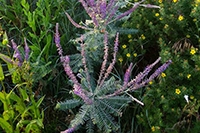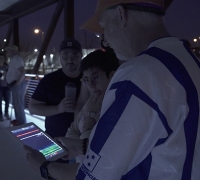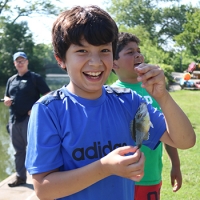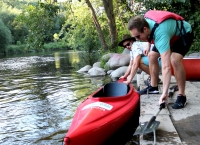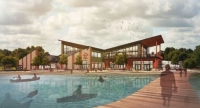
Milwaukee Urban Ecology Blog
Those who prefer instantaneous beauty or plump plants may give up on leadplant (Amorpha canescens) well before it reaches "maturity" at 5+ years of age, but the patient gardener will be rewarded with decades of drought resistant silvery foliage and purple flowers.
When I first started working at the Urban Ecology Center, I had only been in the United States for a year or so. I was still struggling with a lot of stuff: language, friends, work, and what the heck I was going make of myself in this new place. The UEC was my beginning. It was where I began to find myself, my passions, and my place.
The Urban Ecology Center’s Research and Community Science program surveys about 30 different types of wildlife, including birds, mammals, reptiles, amphibians, and invertebrates. This amounts to an estimated 300 field research surveys per year! Among all of this, one project in particular stands out as being part of almost every single work day this spring and summer: acoustic bat monitoring.
Your support helps the Urban Ecology Center’s Green Career Pipeline program develop urban leaders with the commitment and the capability to move our community towards a more sustainable future. Our Green Career Pipeline program starts with school field trips and our Young Scientist Club after-school program, then leads to our High School Outdoor Leader program, which provides two years of job training and paid positions throughout the UEC. Afterwards, students can continue along the path with our paid summer intern programs. This pathway prepares young people for future employment at organizations with an environmental focus, or even here at the UEC!
Famous Wisconsin conservationist, Aldo Leopold was a hunter and fisherman. Not only did these activities provide him with food, they also connected him deeply to the land. In “The Sand County Almanac” he described how draining and channelizing along the Mississippi River wetlands aimed to bring economic growth to the area, but instead left his boyhood marsh “impoverished.” While some may consider fishing a controversial activity, we at the Urban Ecology Center understand that with proper guidance, it can launch a life-long commitment to protecting our local freshwater systems.
Canoes and kayaks are, without a doubt, the most popular items in our equipment lending program. Every weekend throughout the summer months, our boat racks are completely empty, as our members enjoy paddling up and down the Milwaukee River and all throughout our community.
Perhaps you have seen the recent headlines? Urban Ecology Center's $12 million expansion plan at Washington Park would save taxpayers — Milwaukee Journal Sentinel, May 25, 2018 Urban Ecology Center plans $12 million expansion at Washington Park site — Milwaukee BizTimes, May 29, 2018 Yes it’s true, with emphasis on the words “offers” and “plans.”
Milwaukee’s summer months are filled with light! Throughout the city there are fireworks, stage lights, tiki torches and people coming together to enjoy the weather. But if you are looking to spend time away from the massive crowds and hard streets, you don’t need to look very far: nature offers its own set of lights!
Plants lack an immune system like that of animals. However, plants have developed their own unique defenses to detect bacteria, fungi, insects, and vertebrate organism invasion and stop them before mortal damage ensues. Tissue structure and chemistry as well as existing ecological relationships between animals and plants contribute to a plant’s defense and disease resistance. Aside from providing plant strength and rigidity, cell walls, waxy or rubbery films covering leaf and stem tissue, and bark all perform as physical barriers to invasion.
I woke up in the morning to the sound of waves crashing against the shore on Rock Island, about 20 yards from my tent. I moved silently out of the tent so as not to disturb the sleep of my teenage son and stretched my muscles that were sore from yesterday’s bike ride. Enjoying the early morning quiet from my hammock, I reflected on the journey thus far... this was one of the most amazing camping trips I had ever taken, and it wouldn’t have been possible without the Urban Ecology Center.
Copyright © 2023 The Urban Ecology Center

